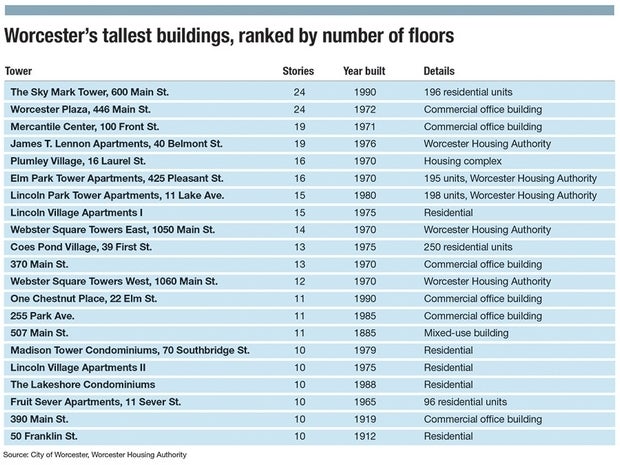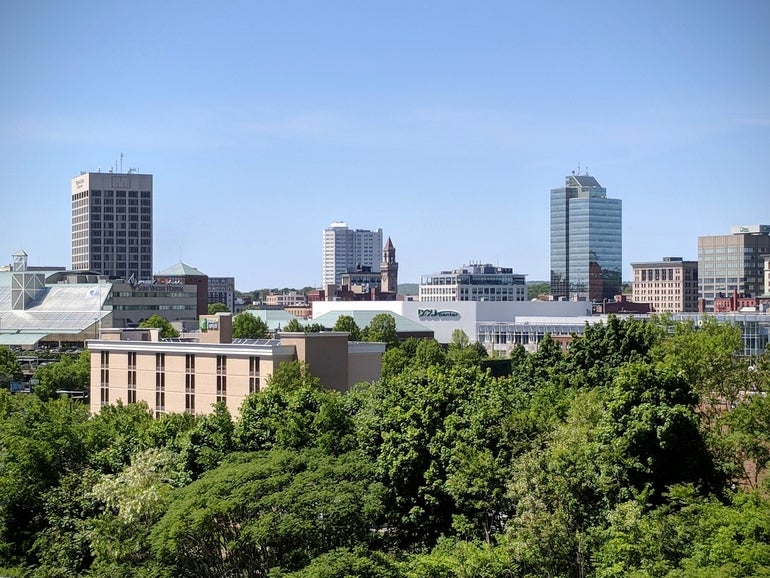When Worcester leaders decided in the 1960s they would tear down a swath of downtown in favor of a new indoor shopping center, they were creating what they saw as a different Worcester for a new era.
Residents were leaving for the suburbs, and new highways could bring them in and out of the city easily. The Galleria mall was built, and included in the project was an unmistakable signal of this new era: a 19-story office tower, by far the tallest building downtown.
The Mercantile Center, as the tower at 100 Front St. is called today, found itself in the middle of a tower boom, at least by Worcester’s standards. And it was supposed to be part of an even larger tower complex. One plan envisioned five towers between 12 and 18 stories each.
Only a year after the Mercantile Center tower opened in 1971, an even taller tower opened a few blocks to the west: Worcester Plaza, a 24-story glass tower. The year prior, a 16-story residential tower opened at 425 Pleasant St. west of downtown, a 13-story office building opened on Main Street and a 16-story residential building opened at Plumley Village, just north of downtown.
The trend toward taller buildings continued with the Sky Mark Tower, a 24-story residential building on Main Street built in 1990.
Then it stopped.
Zero towers – defined here as 10 stories or more – have been built following a two-decade period in which 15 were built.
Towers are typically built for two major reasons: land values are so high to make construction costs viable, or a builder or owner wants to spend on a signature project, said Rob Krueger, an associate professor of social science and policy studies at Worcester Polytechnic Institute.

“Worcester doesn’t really fit into either of those categories,” Krueger said. “We just don’t have that land scarcity issue” like in Boston.
Street development
Starting in the 1960s, urban development was more likely to involve clearing out older and often rundown buildings during an era when people were more apt to drive via highways than walk along sidewalks as they do today.“
When those buildings were built, we were in an era when vertical was good,” Krueger said.
Today, older buildings are more likely to be revitalized using historic tax credits, and instead of a development being more visible with towers, it’s more likely to take place closer to the street. Growth is taking place below the roof lines instead of above it.
As the city’s tower boom came toward an end, construction began taking place elsewhere, like Ledgecrest Drive and Nutmeg Drive, a subdivision of duplexes off Goddard Memorial Drive, as well as Fourth Street and adjacent roads off Mill Street, and the Broadmeadow Brook area of the city, with residential streets off Massasoit Road
New developments replacing the old Galleria mall are far shorter. An office building at 1 Mercantile St. opened in 2012 is seven stories. As for the two opened this year, the 145 Front at City Square apartment complex is five stories, and the adjacent AC Hotel is six.
A few blocks away, the Homewood Suites hotel opened last year across Washington Square from Union Station is six stories.
Two downtown housing developments along Main Street are taking place not in new buildings but in old ones. One, at 332 Main St., involves converting the 1926 building into a new 55-unit development. Another, at the former 1843 Worcester County courthouse at Lincoln Square, will renovate that building into 114 units and retail space.
Stagnant skylines
Larger cities like Boston have skylines seeming to change each week. Drive in from the west on the Massachusetts Turnpike, and among the first buildings you’ll now notice is the 61-story One Dalton tower rising in Back Bay.
But Worcester isn’t alone in smaller Massachusetts cities in having skylines not changing much over the latest few decades.
In Springfield, the state’s third-largest city, none of the three tallest downtown office buildings, two of which are more than 20 stories, were built since the 1980s. In Lowell, the fourth-largest city, the 22-story River Place Towers and the 18-story Fox Hall at UMass Lowell were both built in 1973. The 14-story Cross Point tower complex, a landmark just off I-495, was built in the late 1970s and early ’80s as the headquarters for Wang Laboratories.
Ultimately, having taller towers isn’t especially essential to Worcester, said Amy Finstein, a professor in the visual arts department at the College of the Holy Cross. A lack of newer towers may give off an impression of a less-dynamic city only for those who might reach that conclusion based on a quick impression, she said.
More critically, Finstein said, a change away from towers has meant less clearing away of historical buildings, as was done five decades ago for where Mercantile Center stands today.
“It’s good to see a pause in tearing things down,” she said. “I would say it’s more reflective of a more thoughtful development pattern.”

